Sungjoon Choi
3D Occupancy Prediction with Low-Resolution Queries via Prototype-aware View Transformation
Mar 19, 2025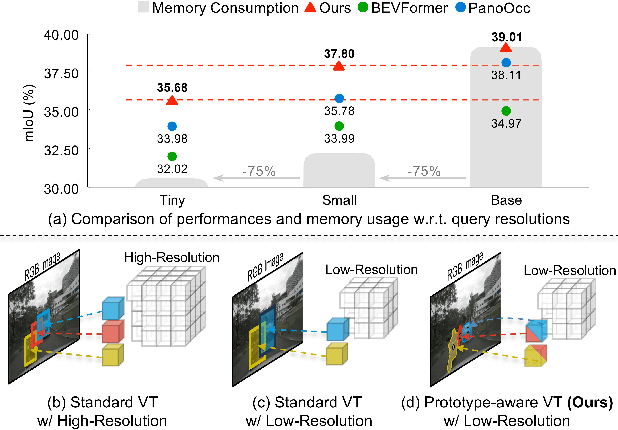
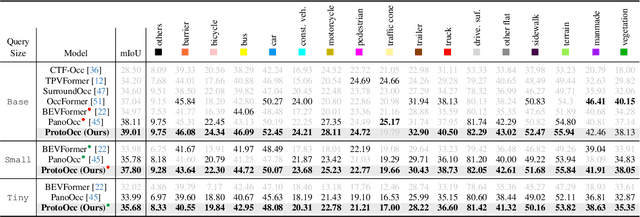
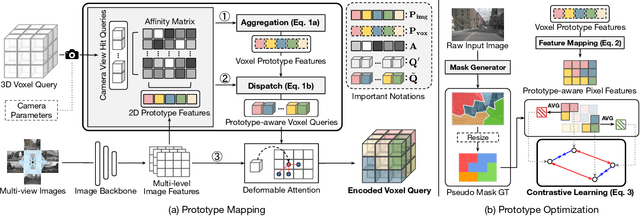
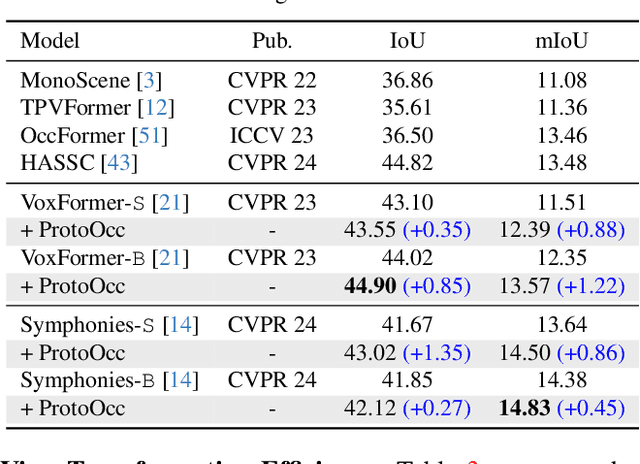
Abstract:The resolution of voxel queries significantly influences the quality of view transformation in camera-based 3D occupancy prediction. However, computational constraints and the practical necessity for real-time deployment require smaller query resolutions, which inevitably leads to an information loss. Therefore, it is essential to encode and preserve rich visual details within limited query sizes while ensuring a comprehensive representation of 3D occupancy. To this end, we introduce ProtoOcc, a novel occupancy network that leverages prototypes of clustered image segments in view transformation to enhance low-resolution context. In particular, the mapping of 2D prototypes onto 3D voxel queries encodes high-level visual geometries and complements the loss of spatial information from reduced query resolutions. Additionally, we design a multi-perspective decoding strategy to efficiently disentangle the densely compressed visual cues into a high-dimensional 3D occupancy scene. Experimental results on both Occ3D and SemanticKITTI benchmarks demonstrate the effectiveness of the proposed method, showing clear improvements over the baselines. More importantly, ProtoOcc achieves competitive performance against the baselines even with 75\% reduced voxel resolution.
Learning-based Dynamic Robot-to-Human Handover
Feb 18, 2025Abstract:This paper presents a novel learning-based approach to dynamic robot-to-human handover, addressing the challenges of delivering objects to a moving receiver. We hypothesize that dynamic handover, where the robot adjusts to the receiver's movements, results in more efficient and comfortable interaction compared to static handover, where the receiver is assumed to be stationary. To validate this, we developed a nonparametric method for generating continuous handover motion, conditioned on the receiver's movements, and trained the model using a dataset of 1,000 human-to-human handover demonstrations. We integrated preference learning for improved handover effectiveness and applied impedance control to ensure user safety and adaptiveness. The approach was evaluated in both simulation and real-world settings, with user studies demonstrating that dynamic handover significantly reduces handover time and improves user comfort compared to static methods. Videos and demonstrations of our approach are available at https://zerotohero7886.github.io/dyn-r2h-handover .
Versatile Motion Langauge Models for Multi-Turn Interactive Agents
Oct 08, 2024Abstract:Recent advancements in large language models (LLMs) have greatly enhanced their ability to generate natural and contextually relevant text, making AI interactions more human-like. However, generating and understanding interactive human-like motion, where two individuals engage in coordinated movements, remains a challenge due to the complexity of modeling these coordinated interactions. Furthermore, a versatile model is required to handle diverse interactive scenarios, such as chat systems that follow user instructions or adapt to their assigned role while adjusting interaction dynamics. To tackle this problem, we introduce VIM, short for the Versatile Interactive Motion language model, which integrates both language and motion modalities to effectively understand, generate, and control interactive motions in multi-turn conversational contexts. To address the scarcity of multi-turn interactive motion data, we introduce a synthetic dataset, INERT-MT2, where we utilize pre-trained models to create diverse instructional datasets with interactive motion. Our approach first trains a motion tokenizer that encodes interactive motions into residual discrete tokens. In the pretraining stage, the model learns to align motion and text representations with these discrete tokens. During the instruction fine-tuning stage, VIM adapts to multi-turn conversations using the INTER-MT2 dataset. We evaluate the versatility of our method across motion-related tasks, motion to text, text to motion, reaction generation, motion editing, and reasoning about motion sequences. The results highlight the versatility and effectiveness of proposed method in handling complex interactive motion synthesis.
Spatio-Temporal Motion Retargeting for Quadruped Robots
Apr 17, 2024Abstract:This work introduces a motion retargeting approach for legged robots, which aims to create motion controllers that imitate the fine behavior of animals. Our approach, namely spatio-temporal motion retargeting (STMR), guides imitation learning procedures by transferring motion from source to target, effectively bridging the morphological disparities by ensuring the feasibility of imitation on the target system. Our STMR method comprises two components: spatial motion retargeting (SMR) and temporal motion retargeting (TMR). On the one hand, SMR tackles motion retargeting at the kinematic level by generating kinematically feasible whole-body motions from keypoint trajectories. On the other hand, TMR aims to retarget motion at the dynamic level by optimizing motion in the temporal domain. We showcase the effectiveness of our method in facilitating Imitation Learning (IL) for complex animal movements through a series of simulation and hardware experiments. In these experiments, our STMR method successfully tailored complex animal motions from various media, including video captured by a hand-held camera, to fit the morphology and physical properties of the target robots. This enabled RL policy training for precise motion tracking, while baseline methods struggled with highly dynamic motion involving flying phases. Moreover, we validated that the control policy can successfully imitate six different motions in two quadruped robots with different dimensions and physical properties in real-world settings.
Visual Preference Inference: An Image Sequence-Based Preference Reasoning in Tabletop Object Manipulation
Mar 18, 2024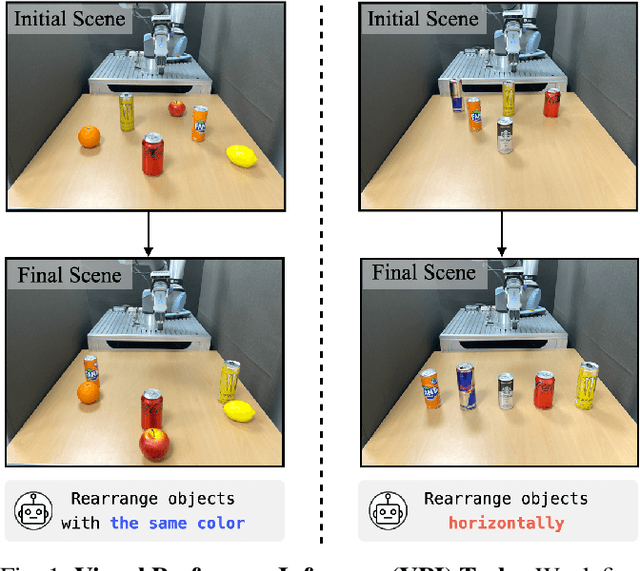

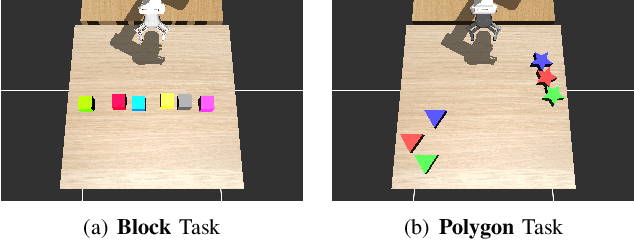

Abstract:In robotic object manipulation, human preferences can often be influenced by the visual attributes of objects, such as color and shape. These properties play a crucial role in operating a robot to interact with objects and align with human intention. In this paper, we focus on the problem of inferring underlying human preferences from a sequence of raw visual observations in tabletop manipulation environments with a variety of object types, named Visual Preference Inference (VPI). To facilitate visual reasoning in the context of manipulation, we introduce the Chain-of-Visual-Residuals (CoVR) method. CoVR employs a prompting mechanism that describes the difference between the consecutive images (i.e., visual residuals) and incorporates such texts with a sequence of images to infer the user's preference. This approach significantly enhances the ability to understand and adapt to dynamic changes in its visual environment during manipulation tasks. Furthermore, we incorporate such texts along with a sequence of images to infer the user's preferences. Our method outperforms baseline methods in terms of extracting human preferences from visual sequences in both simulation and real-world environments. Code and videos are available at: \href{https://joonhyung-lee.github.io/vpi/}{https://joonhyung-lee.github.io/vpi/}
Towards Embedding Dynamic Personas in Interactive Robots: Masquerading Animated Social Kinematics (MASK)
Mar 15, 2024



Abstract:This paper presents the design and development of an innovative interactive robotic system to enhance audience engagement using character-like personas. Built upon the foundations of persona-driven dialog agents, this work extends the agent application to the physical realm, employing robots to provide a more immersive and interactive experience. The proposed system, named the Masquerading Animated Social Kinematics (MASK), leverages an anthropomorphic robot which interacts with guests using non-verbal interactions, including facial expressions and gestures. A behavior generation system based upon a finite-state machine structure effectively conditions robotic behavior to convey distinct personas. The MASK framework integrates a perception engine, a behavior selection engine, and a comprehensive action library to enable real-time, dynamic interactions with minimal human intervention in behavior design. Throughout the user subject studies, we examined whether the users could recognize the intended character in film-character-based persona conditions. We conclude by discussing the role of personas in interactive agents and the factors to consider for creating an engaging user experience.
Past as a Guide: Leveraging Retrospective Learning for Python Code Completion
Nov 13, 2023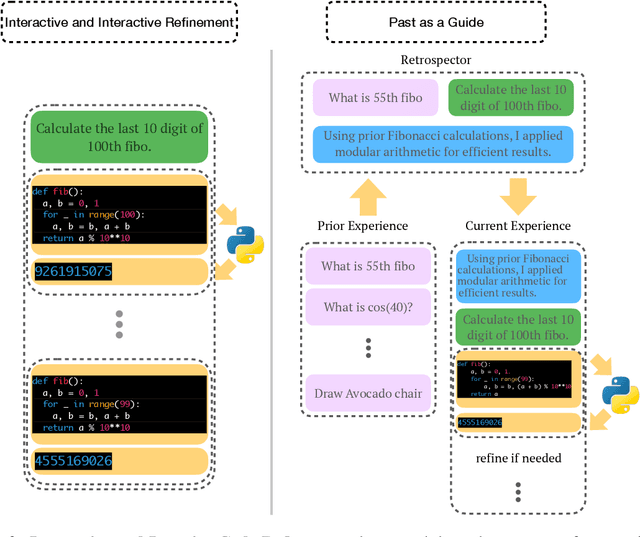

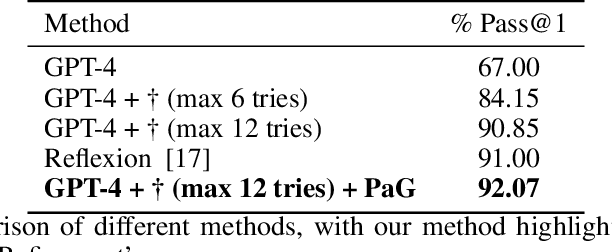
Abstract:This work presents Past as a Guide (PaG), a simple approach for Large Language Models (LLMs) to improve the coding capabilities by integrating the past history with interactive and iterative code refinements. To be specific, inspired by human cognitive processes, the proposed method enables LLMs to utilize previous programming and debugging experiences to enhance the Python code completion tasks. The framework facilitates LLMs to iteratively refine the Python code based on previous execution and debugging results and optimize learning and reasoning capabilities. The proposed methodology achieved a 92\% pass@1 on HumanEval, demonstrating the potential to advance the field by leveraging retrospection from past experiences and interactive and iterative refinement processes without external correctness indicators.
SPOTS: Stable Placement of Objects with Reasoning in Semi-Autonomous Teleoperation Systems
Sep 25, 2023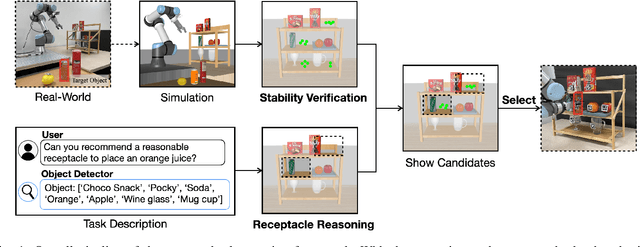
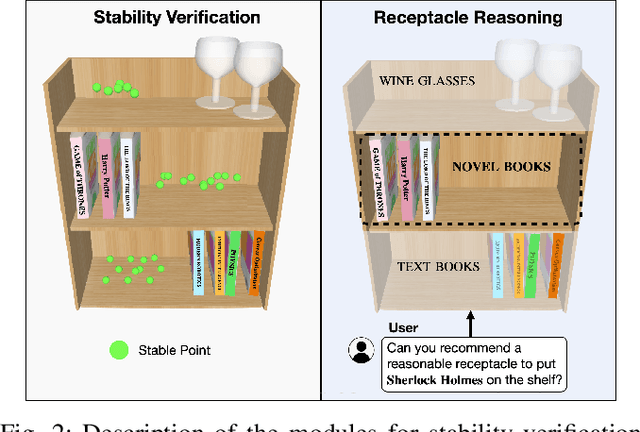
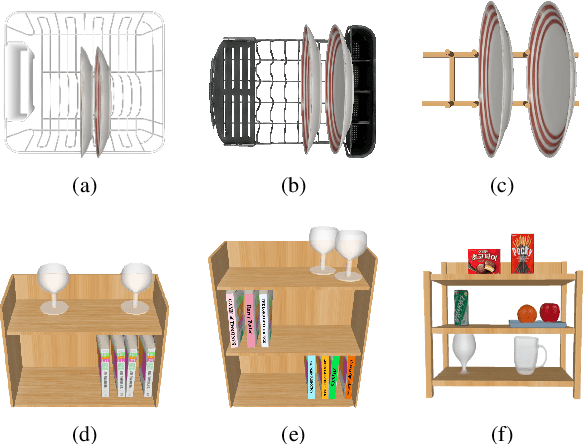
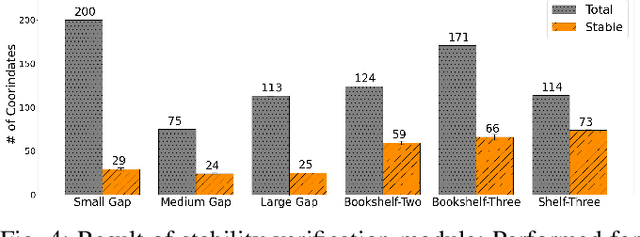
Abstract:Pick-and-place is one of the fundamental tasks in robotics research. However, the attention has been mostly focused on the ``pick'' task, leaving the ``place'' task relatively unexplored. In this paper, we address the problem of placing objects in the context of a teleoperation framework. Particularly, we focus on two aspects of the place task: stability robustness and contextual reasonableness of object placements. Our proposed method combines simulation-driven physical stability verification via real-to-sim and the semantic reasoning capability of large language models. In other words, given place context information (e.g., user preferences, object to place, and current scene information), our proposed method outputs a probability distribution over the possible placement candidates, considering the robustness and reasonableness of the place task. Our proposed method is extensively evaluated in two simulation and one real world environments and we show that our method can greatly increase the physical plausibility of the placement as well as contextual soundness while considering user preferences.
CLARA: Classifying and Disambiguating User Commands for Reliable Interactive Robotic Agents
Jun 22, 2023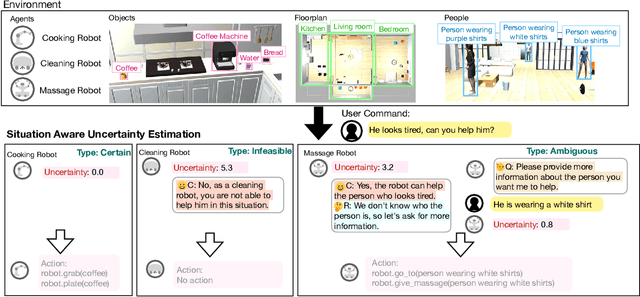



Abstract:In this paper, we focus on inferring whether the given user command is clear, ambiguous, or infeasible in the context of interactive robotic agents utilizing large language models (LLMs). To tackle this problem, we first present an uncertainty estimation method for LLMs to classify whether the command is certain (i.e., clear) or not (i.e., ambiguous or infeasible). Once the command is classified as uncertain, we further distinguish it between ambiguous or infeasible commands leveraging LLMs with situational aware context in a zero-shot manner. For ambiguous commands, we disambiguate the command by interacting with users via question generation with LLMs. We believe that proper recognition of the given commands could lead to a decrease in malfunction and undesired actions of the robot, enhancing the reliability of interactive robot agents. We present a dataset for robotic situational awareness, consisting pair of high-level commands, scene descriptions, and labels of command type (i.e., clear, ambiguous, or infeasible). We validate the proposed method on the collected dataset, pick-and-place tabletop simulation. Finally, we demonstrate the proposed approach in real-world human-robot interaction experiments, i.e., handover scenarios.
Towards Text-based Human Search and Approach with an Intelligent Robot Dog
Feb 10, 2023Abstract:In this paper, we propose a SOCratic model for Robots Approaching humans based on TExt System (SOCRATES) focusing on the human search and approach based on free-form textual description; the robot first searches for the target user, then the robot proceeds to approach in a human-friendly manner. In particular, textual descriptions are composed of appearance (e.g., wearing white shirts with black hair) and location clues (e.g., is a student who works with robots). We initially present a Human Search Socratic Model that connects large pre-trained models in the language domain to solve the downstream task, which is searching for the target person based on textual descriptions. Then, we propose a hybrid learning-based framework for generating target-cordial robotic motion to approach a person, consisting of a learning-from-demonstration module and a knowledge distillation module. We validate the proposed searching module via simulation using a virtual mobile robot as well as through real-world experiments involving participants and the Boston Dynamics Spot robot. Furthermore, we analyze the properties of the proposed approaching framework with human participants based on the Robotic Social Attributes Scale (RoSAS)
 Add to Chrome
Add to Chrome Add to Firefox
Add to Firefox Add to Edge
Add to Edge